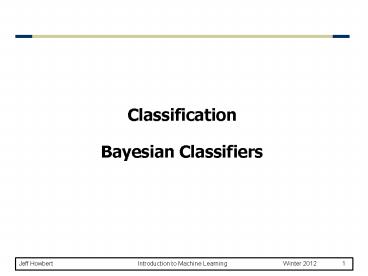Classification Bayesian Classifiers - PowerPoint PPT Presentation
1 / 15
Title:
Classification Bayesian Classifiers
Description:
Bayesian Classifiers A probabilistic framework for solving classification problems. Used where class assignment is not deterministic, i.e. a particular set of ... – PowerPoint PPT presentation
Number of Views:100
Avg rating:3.0/5.0
Title: Classification Bayesian Classifiers
1
ClassificationBayesian Classifiers
2
Bayesian classification
- A probabilistic framework for solving
classification problems. - Used where class assignment is not deterministic,
i.e. a particular set of attribute values will
sometimes be associated with one class, sometimes
with another. - Requires estimation of posterior probability for
each class, given a set of attribute values - for each class Ci
- Then use decision theory to make predictions for
a new sample x
3
Bayesian classification
- Conditional probability
- Bayes theorem
likelihood
prior probability
posterior probability
evidence
4
Example of Bayes theorem
- Given
- A doctor knows that meningitis causes stiff neck
50 of the time - Prior probability of any patient having
meningitis is 1/50,000 - Prior probability of any patient having stiff
neck is 1/20 - If a patient has stiff neck, whats the
probability he/she has meningitis?
5
Bayesian classifiers
- Treat each attribute and class label as random
variables. - Given a sample x with attributes ( x1, x2, , xn
) - Goal is to predict class C.
- Specifically, we want to find the value of Ci
that maximizes p( Ci x1, x2, , xn ). - Can we estimate p( Ci x1, x2, , xn ) directly
from data?
6
Bayesian classifiers
- Approach
- Compute the posterior probability p( Ci x1, x2,
, xn ) for each value of Ci using Bayes
theorem - Choose value of Ci that maximizes p( Ci x1,
x2, , xn ) - Equivalent to choosing value of Ci that
maximizes p( x1, x2, , xn Ci ) p( Ci ) - (We can ignore denominator why?)
- Easy to estimate priors p( Ci ) from data.
(How?) - The real challenge how to estimate p( x1, x2,
, xn Ci )?
7
Bayesian classifiers
- How to estimate p( x1, x2, , xn Ci )?
- In the general case, where the attributes xj have
dependencies, this requires estimating the full
joint distribution p( x1, x2, , xn ) for each
class Ci. - There is almost never enough data to confidently
make such estimates.
8
Naïve Bayes classifier
- Assume independence among attributes xj when
class is given - p( x1, x2, , xn Ci ) p( x1 Ci ) p( x2
Ci ) p( xn Ci ) - Usually straightforward and practical to estimate
p( xj Ci ) for all xj and Ci. - New sample is classified to Ci if
- p( Ci ) ? p( xj Ci )
- is maximal.
9
How to estimate p ( xj Ci ) from data?
- Class priorsp( Ci ) Ni / N
- p( No ) 7/10
- p( Yes ) 3/10
- For discrete attributes
- p( xj Ci ) xji / Ni
- where xji is number of instances in class Ci
having attribute value xj - Examples
- p( Status Married No ) 4/7
- p( Refund Yes Yes ) 0
10
How to estimate p ( xj Ci ) from data?
- For continuous attributes
- Discretize the range into bins
- replace with an ordinal attribute
- Two-way split ( xi lt v ) or ( xi gt v )
- replace with a binary attribute
- Probability density estimation
- assume attribute follows some standard
parametric probability distribution (usually
a Gaussian) - use data to estimate parameters of distribution
(e.g. mean and variance) - once distribution is known, can use it to
estimate the conditional probability p( xj
Ci )
11
How to estimate p ( xj Ci ) from data?
- Gaussian distribution
- one for each ( xj, Ci ) pair
- For ( Income Class No )
- sample mean 110
- sample variance 2975
12
Example of using naïve Bayes classifier
Given a Test Record
- p( x Class No ) p( Refund No Class
No) ? p( Married Class No ) ? p(
Income 120K Class No ) 4/7
? 4/7 ? 0.0072 0.0024 - p( x Class Yes ) p( Refund No Class
Yes) ? p( Married Class
Yes ) ? p( Income
120K Class Yes ) 1 ? 0 ?
1.2 ? 10-9 0 - p( x No ) p( No ) gt p( x Yes ) p( Yes )
- therefore p( No x ) gt p( Yes x )
- gt Class No
13
Naïve Bayes classifier
- Problem if one of the conditional probabilities
is zero, then the entire expression becomes zero. - This is a significant practical problem,
especially when training samples are limited. - Ways to improve probability estimation
c number of classes p prior probability m
parameter
14
Example of Naïve Bayes classifier
X attributes M class mammal N class
non-mammal
p( X M ) p( M ) gt p( X N ) p( N ) gt mammal
15
Summary of naïve Bayes
- Robust to isolated noise samples.
- Handles missing values by ignoring the sample
during probability estimate calculations. - Robust to irrelevant attributes.
- NOT robust to redundant attributes.
- Independence assumption does not hold in this
case. - Use other techniques such as Bayesian Belief
Networks (BBN).































